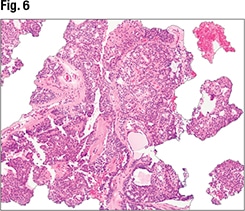March 2022—Few people want to talk about burnout in health care—at least not publicly. Take, for example, the response of one laboratory professional, who, when asked to be interviewed for this story, waited several days before ultimately declining. Having his institution associated with the topic, he explained, could fan the flames among colleagues. “For sure all of us are feeling weary,” he said in an email (quoted with permission). “And I don’t want this in the face of our team members who are chronically short-staffed while seeing large hiring and retention bonuses going to nurses and others at the bedside. Those payouts are choking off access to capital for replacement equipment and causing every non-nursing position to go through a weekly labor committee review,” with finance leaders evaluating all replacement requests based on funding ability and productivity. “We all have some burnout,” he continued, noting the number of people retiring or trying new careers. The response ticks many boxes on the aspects-of-burnout list.
Read More »March 2022
Close-up on common diagnoses in core biopsies
March 2022—Papillary and fibroepithelial lesions of the breast were the focus of a talk given by Xiaoxian (Bill) Li, MD, PhD, in a CAP21 session on common but challenging diagnoses in breast core biopsies.
Read More »Dark days are over, but new and old challenges pile up
March 2022—The omicron surge was waning on Feb. 1 when Compass Group members met by Zoom with CAP TODAY publisher Bob McGonnagle. Inpatient numbers, test demand, and positivity rates were declining. “We’re on the downslope,” Northwell Health’s Dwayne Breining, MD, reported. But other pressures persist: the shortages of blood and staff.
Read More »At Penn State, a fast track to pathology residency
March 2022—A new program called Pathology Accelerated Pathway at Penn State shepherds pathology-bound students toward residency readiness in three years instead of four and is set to begin this spring.
Read More »Next-level testing for allergy, autoimmune disease
March 2022—Recent years have seen new releases in allergy and autoimmune disease testing that move the fields forward. “On average we’re looking at six to 10 years of a patient going through the process of seeing specialist after specialist and finally reaching a diagnosis,” Veena Joy, MSc, PhD.
Read More »Molecular oncology tumor board: The curious cases of medullary thyroid cancer
March 2022—Most thyroid cancer cases are straightforward, but a small percentage are not. In a CAP21 molecular oncology tumor board session, Justin Bishop, MD, and Saad Khan, MD, spotlighted one of the latter.
Read More »New illustrated guide to bone marrow based on PT
March 2022—CAP Publications will release this spring volume two of the second edition of the Color Atlas of Hematology—on bone marrow. It continues in the tradition of its predecessor on peripheral blood cells (volume one, 2018): morphologic identification of cells based on proficiency testing. The senior and associate editors have organized the various components of volume two into “an eminently readable, practical, and in many respects entertaining resource for anyone interested in bone marrow morphology, physiology, and pathophysiology,” Donald S. Karcher, MD, of George Washington University, writes in the foreword.
Read More »Connectivity and control—pivotal issues at the POC
March 2022—How can we connect these point-of-care devices? How do we standardize and ensure competency? How do we get the results from at-home testing? How can we integrate point-of-care information into the whole of analytics? Just some of the questions those who lead POC testing and make it possible are asking today. They spoke with CAP TODAY publisher Bob McGonnagle on Jan. 25 in a virtual roundtable on POC instruments and system connectivity.
Read More »From the President’s Desk
Strengthen your state societies
March 2022—If you’re reading this column, you’re likely a member of the CAP. But are you also a member of your state pathology society? Too many pathologists think that joining the CAP is enough. The truth is, the CAP can have a greater impact—and pathologists can be more effective physician advocates for their patients—when partnering with robust state pathology societies. State societies are essential because so many of the policies and regulations governing our work as pathologists are enacted at the state level. Balance billing rules, scope of practice issues, and insurance regulations are often decided by each state. So many issues about how we are licensed, how we practice, and how we get paid are regulated at the state level.
Clinical pathology selected abstracts
March 2022—Many people infected with SARS-CoV-2 do not develop severe symptoms and, therefore, may not know they are infected. Serological testing may help identify those who are asymptomatic and, thereby, reduce transmission.
Read More »Anatomic pathology selected abstracts
March 2022—Invasive gallbladder carcinoma is preceded by two main types of precursor lesions—intracholecystic papillary-tubular neoplasms and biliary intraepithelial neoplasias. Invasive gallbladder carcinomas with an intracholecystic papillary-tubular neoplasm (ICPN) component have more favorable prognoses than those without an ICPN component.
Read More »Molecular pathology selected abstracts
March 2022—Why are immunotherapies effective for some patients but not others—even among those with the same histologic tumor type and similar mutational burdens?
Read More »Pathology informatics selected abstracts
March 2022—Over the past decade, the field of pathology has increasingly been using Twitter for educational purposes, due in part to the ease with which one can share images for review on the social media platform. However, not all pathologists use Twitter, and only a portion of those who do use it employ the platform for educational purposes. To identify the challenges of using Twitter to create educational posts, the authors created a short multiple-choice Likert scale survey using Google Forms and distributed it through Twitter. The survey was divided into the categories of user demographics—work setting, job role, and history of posting educational content on Twitter; the biggest obstacle to creating educational content; and further exploration of the challenges faced when posting content to Twitter. One hundred and seventy-four medical professionals responded to the survey, of which pathology residents and fellows (n = 68; 39.1 percent) and practicing pathologists (n = 60; 34.5 percent) composed the largest groups.
Read More »Q&A column
March 2022 Q. Are Pancoast tumors a fast-growing, untreatable cancer? Read answer. Q. When performing reagent lot-to-lot correlation studies, some staff believe it is better to perform instrument calibration before a new reagent lot check while others believe calibration is not necessary. What is the appropriate practice? Read answer.
Read More »Newsbytes
March 2022—Medical professionals and, more importantly, patients at Virginia Commonwealth University Medical Center are benefitting from a synoptic reporting system that allows the pathology lab to assess the quality of all bone marrow specimens that it receives.
Read More »Put It on the Board
March 2022—The CAP was one of eight pathology and laboratory organizations to endorse in a joint statement the use of the CKD-EPI 2021 race-free equations for calculating estimated glomerular filtration rate. The others are the Academy of Clinical Laboratory Physicians and Scientists, American Association of Clinical Chemistry, American Society for Clinical Pathology, Association of Pathology Chairs, Clinical Laboratory Management Association, National Independent Laboratory Association, and Society of American Federated Medical Laboratory Scientists (the views of the SAFMLS do not represent the views of the U.S. government). Following is the statement they released on Jan. 31.
Read More »Letters
March 2022—This is in regard to the article in CAP TODAY, January 2022, “What influences med students to choose pathology?” which discusses reasons for the low enrollment in pathology residencies. The article is informative but there is no mention of an important resource we established at the CAP Foundation.
Read More » CAP TODAY Pathology/Laboratory Medicine/Laboratory Management
CAP TODAY Pathology/Laboratory Medicine/Laboratory Management



